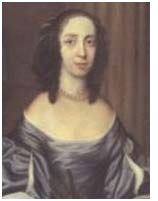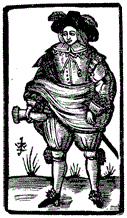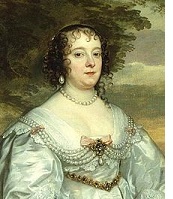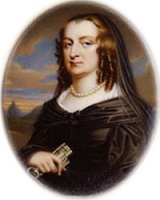
Women in the Civil Wars

Introduction
When the Civil War started, Margaret Eure wrote: 'All that women can do is to pray for better times.' Women in Tudor and Stuart times were thought to be 'the weaker vessel' – weaker, gentler and less intelligent than men.
The war changed all that. In 1645, the poet James Strong wrote: 'To most it's known, the weaker vessels are stronger grown.'
The information on this webpage will tell you about some women in the Civil War.
After you have studied this webpage, answer the question sheet by clicking on the 'Time to Work' icon at the top of the page.
Links:
The following websites will help you research further:
Women in the English Civil
War:
• Women's lives in the Civil Wars
•
Wikipedia index for 14 significant women in the Civil War
•
Women's clothing during the Civil Wars
 Lady Lucy Hutchinson nursed wounded soldiers of both sides. She was not frightened when a Roundhead captain complained that she was helping Royalists. She told him that she had done
'nothing but her duty, in humanity to them'.
Lady Lucy Hutchinson nursed wounded soldiers of both sides. She was not frightened when a Roundhead captain complained that she was helping Royalists. She told him that she had done
'nothing but her duty, in humanity to them'.
 Some women, like 'Mr Clarke', dressed themselves in men's clothes and joined the army.
'Mr Clarke' fired a musket, wrestled, drank and smoked like the other
soldiers, and was only discovered when 'he' gave birth to a baby boy!
Some women, like 'Mr Clarke', dressed themselves in men's clothes and joined the army.
'Mr Clarke' fired a musket, wrestled, drank and smoked like the other
soldiers, and was only discovered when 'he' gave birth to a baby boy!
In many towns, women raised money for the army. The women were called 'Maiden troops'.
Elizabeth Alkin acted as a nurse and a spy and wrote pamphlets supporting Parliament.
In 1643, during the siege of Lyme in Dorset, the women of the town threw rocks at the attackers and filled the defenders' cartridges with gunpowder. One woman lost her hand during the siege, but she said: 'I am glad that I had a hand to lose for Jesus Christ, and am willing to lose my life also.'
When Charles I was in prison after the war, Jane Whorwood carried messages and money to him. She also smuggled acid to him to dissolve the bars of his cell. When Charles was executed, Jane was one of the few who dared to cheer for him.
During the siege of Nottingham in 1643, while the men fought, women walked round looking for fires to put out.
During the siege of Gloucester in 1644, women helped to build the earth mounds to defend the town.
 In 1645, Charlotte, Countess of Derby, defended Lathom House in Derbyshire so fiercely that people said she had 'stolen her husband's trousers'.
In 1645, Charlotte, Countess of Derby, defended Lathom House in Derbyshire so fiercely that people said she had 'stolen her husband's trousers'.
 Mary,
Lady Bankes, defended Corfe Castle in Dorset for most of the war.
Helped by her daughters, her maids and five soldiers, she dropped stones
and hot ashes on the enemy as they climbed their scaling ladders.
Mary,
Lady Bankes, defended Corfe Castle in Dorset for most of the war.
Helped by her daughters, her maids and five soldiers, she dropped stones
and hot ashes on the enemy as they climbed their scaling ladders.
Lady Cholmley helped her husband during the siege of Scarborough Castle in 1644. She tended the wounded while he defended the castle. He said that 'though by nature timid, she showed a courage above her sex'.
Women had to cope when their husbands left home to join the army. 'I am a lone woman,' complained one wife. Another wrote to her soldier husband: 'Why can everyone come home except you?'
In 1643, more than six thousand women marched to the House of Commons to ask Parliament to make peace with the king. They were driven away by soldiers. Some were killed.
After the war, in 1649, women presented The Petition of Women to Parliament. It demanded 'rights and freedom . .. and a share in the government'. When they were told to 'stay home and wash the dishes', they said that the war had left them no dishes to wash.
Many women had to suffer the horrors of war. Alice Stonier of Staffordshire and her five children were robbed and their house was burned down. Her husband Thomas was 'pressed' into the army — and killed almost immediately. The family ended up sleeping in 'the fields.
Lucy Hay, Countess of Carlysle, stayed at the King's court throughout the war ... whilst passing information to the Parliamentarians (it was Lucy Hay who warned John Pym that the king was coming to arrest him in 1642)! After the war, she acted as an intermediary between the two sides, helped Charles I during the Second Civil War, was sent to the Tower ... but lived to help organise Charles II's restoration in 1660.